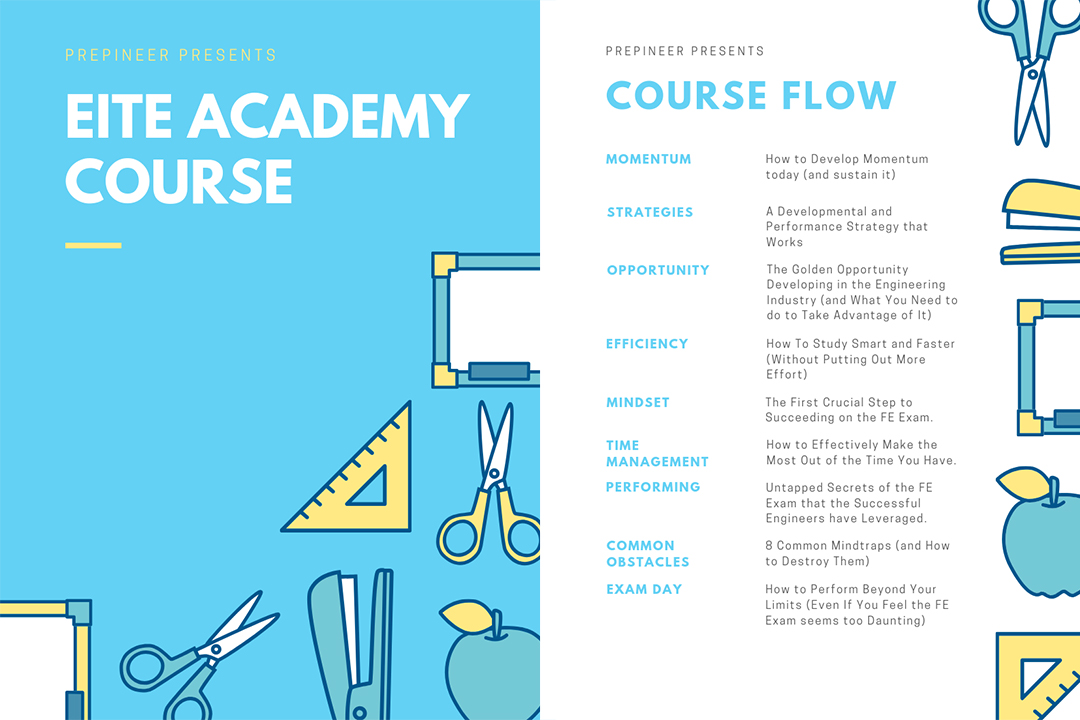The following is a breakdown of the 11 topics covered in the Chemical PM portion of the Engineer in Training Exam.
The percentage next to the subject is approximately how much of the total content of the PM session that particular subject makes up. This breakdown is as outlined by NCEES on their website.
I. Chemistry (10% )
A. Inorganic chemistry (e.g., molarity, normality, molality, acids,
bases, redox, valence, solubility product, pH, pK, electrochemistry)
B. Organic chemistry (e.g., nomenclature, structure, qualitative and quantitative
analyses, balanced equations, reactions, synthesis)
II. Material/Energy Balances (15%)
A. Mass balance
B. Energy balance
C. Control boundary concept (e.g., black box concept)
D. Steady-state process
E. Unsteady-state process
F. Recycle process
G. Bypass process
H. Combustion
III. Chemical Engineering Thermodynamics (10%)
A. Thermodynamic laws (e.g., 1st Law, 2nd Law)
B. Thermodynamic properties (e.g., internal thermal energy, enthalpy, entropy, free energy)
C. Thermodynamic processes (e.g., isothermal, adiabatic, isentropic)
D. Property and phase diagrams (e.g., T-s, h-P, x-y, T-x-y)
E. Equations of state (e.g., van der Waals, Soave-Redlich-Kwong)
F. Steam tables
G. Phase equilibrium and phase change
H. Chemical equilibrium
I. Heats of reaction
J. Cyclic processes and efficiency (e.g., power, refrigeration, heat pump)
K. Heats of mixing
IV. Fluid Dynamics (10%)
A. Bernoulli equation and mechanical energy balance
B. Hydrostatic pressure
C. Dimensionless numbers (e.g., Reynolds number)
D. Laminar and turbulent flow
E. Velocity head
F. Friction losses (e.g., pipe, valves, fittings)
G. Pipe networks
H. Compressible and incompressible flow
I. Flow measurement (e.g., orifices, Venturi meters)
J. Pumps, turbines, and compressors
K. Non-Newtonian flow
L. Flow through packed beds
V. Heat Transfer (10%)
A. Conductive heat transfer
B. Convective heat transfer
C. Radiation heat transfer
D. Heat transfer coefficients
E. Heat exchanger types (e.g., plate and frame, spiral)
F. Flow configuration (e.g., cocurrent/countercurrent)
G. Log mean temperature difference (LMTD) and NTU
H. Fouling
I. Shell-and-tube heat exchanger design (e.g., area, number of passes)
VI. Mass Transfer (10%)
A. Diffusion (e.g., Fick’s 1st and 2nd laws)
B. Mass transfer coefficient
C. Equilibrium stage method (efficiency)
D. Graphical methods (e.g., McCabe-Thiele)
E. Differential method (e.g., NTU, HETP, HTU, NTP)
F. Separation systems (e.g., distillation, absorption, extraction, membrane processes)
G. Humidification and drying
VII. Chemical Reaction Engineering (10%)
A. Reaction rates and order
B. Rate constant (e.g., Arrhenius function)
C. Conversion, yield, and selectivity
D. Series and parallel reactions
E. Forward and reverse reactions
F. Energy/material balance around a reactor
G. Reactions with volume change
H. Reactor types (e.g., plug flow, batch, semi-batch, CSTR)
I. Homogeneous and heterogeneous reactions
J. Catalysis
VIII. Process Design and Economic Optimization (10%)
A. Process flow diagrams (PFD)
B. Piping and instrumentation diagrams (P&ID)
C. Scale-up
D. Comparison of economic alternatives (e.g., net present value, discounted cash flow, rate of return)
E. Cost estimation
IX. Computer Usage in Chemical Engineering (5%)
A. Numerical methods and concepts (e.g., convergence, tolerance)
B. Spreadsheets for chemical engineering calculations
C. Statistical data analysis
X. Process Control (5%)
A. Sensors and control valves (e.g., temperature, pressure)
B. Dynamics (e.g., time constants, 2nd order, underdamped)
C. Feedback and feedforward control
D. Proportional, integral, and derivative (PID) controller concepts
E. Cascade control
F. Control loop design (e.g., matching measured and manipulated variables)
G. Tuning PID controllers and stability (e.g., Method of Ziegler-Nichols, Routh Test)
H. Open-loop and closed-loop transfer functions
XI. Safety, Health, and Environmental (5%)
A. Hazardous properties of materials (e.g., corrosive, flammable, toxic), including MSDS
B. Industrial hygiene (e.g., noise, PPE, ergonomics)
C. Process hazard analysis (e.g., using fault-tree analysis or event tree)
D. Overpressure and underpressure protection (e.g., relief, redundant control, intrinsically safe)
E. Storage and handling (e.g., inerting, spill containment)
F. Waste minimization
G. Waste treatment (e.g., air, water, solids)
Source NCEES





